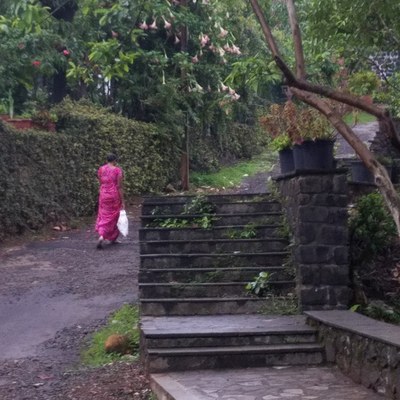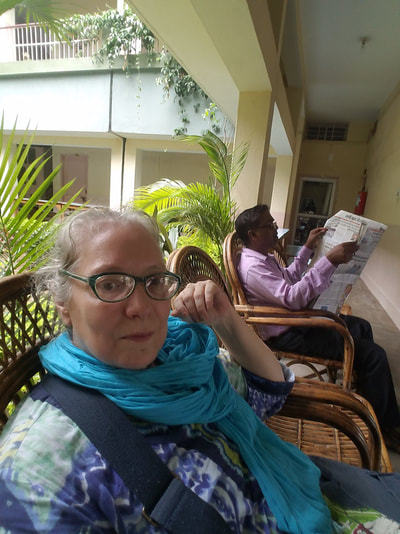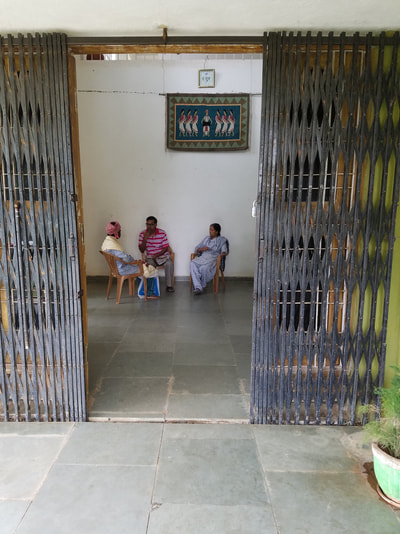|
Here is a summary of the trip and some of my favorite pictures along the way. In many ways I wasn't sure why I was going on this trip. Initially I had wanted to take my kids before their lives got too busy, but their lives got too busy, and so they couldn't come but I decided to go anyway. When I got there I realised what things were very important and special about this trip, for me and for others. MumbaiBecause a dear friend lives in Mumbai, I enjoy having Mumbai be my point of entry into the country. There is nothing like seeing Mumbai with a Mumbaikar, you quickly get a sense of how to navigate those busy and uneven streets and see perhaps things that just aren't on the regular tourist route.....though it is always nice to visit a few of those too. LonavalaHowever when I first arrived in Mumbai there was a break in the monsoon, that had just started and so it was incredibly hot. So my friend and I escaped to the hills, the Western Ghats just outside of Mumbai. There the rain was regular, though not as forocious as it gets later on. Here life is simply and slow and nature does sings making you so aware of the rich abundance of invisible and visible goodness that surrounds us. RanchiI truly love staying at the HRDC (Human Recource and Development Center) Guest House. Primarily because the staff are so delightful and I can just sit in the lobby and meet the most interesting people. I did very briefly go to the "Theologica" or the Gossner Theological College (GTC) and to the GELC (Gossner Evangelical Lutheran Church of Chota Nagpur and Assam). I enjoyed speaking to the staff of the "Gharbandhu" which is the regions oldest newspaper, a hindu publication for the church. We spoke about how I can share pictures and short stories that they can translate and publish. Just before I left, I thought it would be a good idea to print out a copy of the translation work that my father has done of two histories written in old German by two of my great great grandfathers: Ferdinand Hahn and Ludwig Nottrott. [Note as far as we know Ludwig never came to India, but he wrote down this history based on the information sent to him by his brother, Alfred Nottrott who was a co-worker with Ferdinand Hahn. Ferdinand's oldest daughter, Louise, and Ludwig's oldest son, Karl W, married and are my great great grandparents] When I was having this work translated for my own research, I realized how valuable this history would be for the Adivasi people of Chota Nagpur. This may be one of the only and oldest histories. Why it was never translated earlier and put into their hands I do not know. it was most significant that I brought to them these vital histories for them and have asked both the GEL: and the NWGEL to publish these works, and translate them into Hindi. So that more people will know their history. I did not know how well received this gift that I left with the two seminarys would be. It is such a joy for people to have in their own hands one of the most important versions of their own history for the first time. Malar / Lohardaga / ChattiThe last couple of times I spent a lot of time with the GELC and the GTC, staying in Ranchi and traveling out to various outposts such as Purulia, Chaibassa, Jhamshedpur, and Lohardaga. There are still many other places that I would love to see, but I have a feeling I have a long history here and will be returning and have other options to see other places of this 2nd largest Lutheran church in India. For those who don't know there has been a split since the 1970s in the church so currently there is the GELC and the NWGELC, they have a common history and many other things in common, however, they both also have some unique differences. In any case, I had not spent much time at the NWGELC Navin Doman Theological seminary in Malar. So this time I spent half my time there. I was asked to share part of the history that I have learned with them and gave two lectures that I have now shared in this blog (6 parts). Malar is out on the edge of Ranchi in the country alongside a forest that is shared by three Adivasi villages. Again it is very peaceful there. My hosts are recognized as advocates for the community, and people come to them from the village about advise. Once again the students are often singing, dancing and drumming. On Sunday we went to church in Lohardaga, where Ferdinand and Doris lived for over twenty years. (1878-1900). The elders and the youth were very interested to learn from me more about their history. They asked me some great questions and I was really appreciative to learn what parts of the biography I am writing of Ferdinand are important to them. On the way back from Lohardaga to Malar we stopped at a little church in Chatti that was built in 1883. I had mentioned the origins of this church in my lecture and now it was good to see that it was still standing, and perhaps little changed from those early days. There is a huge mango tree that looks as old as the church. I always wish that the trees could talk to tell us more of our histories. Delhi The time in Ranchi and Malar went by too quickly. I flew to Delhi truly dreading the weather and pollution there. For over a month they had very high temperatures and in addition to the worst pollution in the world they were having dust storms coming in from the dessert. But before I got there a little rain had fallen, enough to clear the skies. I've been very fortunate the last three times I've been in Delhi over the past five years that the days I have been there have been beautiful. But I had a very bad cold so I mostly spent time staying in my hotel room at the YWCA and recuperating. I just want to make a comment about the fact that I have been working on uploading pictures off my phone into my Google Folder and writing this blog. The whole time I was in India it would take ten times longer to do what I have accomplished today! I really appreciate the connectivity that I have in this country! And I appreciate why the answers coming from emails in India always seem to take longer. Pretty much the only thing I did while I was in Delhi was to visit Jawaharlal Nehru University (JNU) to visit some social scientists who have also been working on this history of the Adivasi. The campus is so beautiful, a jungle with nealguy deer wandering around and peacocks jumping from the trees and flying across the sky. It was a hot evening and I was weak from recovering, but I really enjoyed not only the campus but also the great conversation. I have been very encouraged that I should be able to publish in India. KalimpongThe tag on to the trip was a week long writing retreat that I took with my friend up in Kalimpong. Five years ago we began to go on these writing retreats and have chosen a different hill station each time. We were anticipating a lot of rain up in this northeastern West Bengal town just on the Sikkim boarder, but it only rained twice during the day the whole time we were there. We spent most of our time writing, but would always have an excursion out either into town or walk out into the hills. It was a beautiful place and I was able to do a lot of editing on my book. Where we stayed would have a beautiful view of the Kinchinjunga range, but we were lucky to get a faint outline through the clouds.
0 Comments
Leave a Reply. |
2016 -2020These musings include the journey of my writing on the history of my great great grandparents and the travels for research to India, Germany and other places of interest. Archives
June 2020
Categories |




















 RSS Feed
RSS Feed